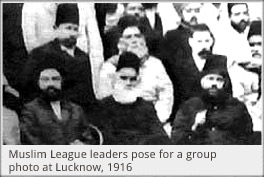When All India Muslim League came into existence, it was a moderate organization with its basic aim to establish friendly relations with the Crown. However, due to the decision of the British Government to annul the partition of Bengal, the Muslim leadership decided to change its stance. In 1913, a new group of Muslim leaders entered the folds of the Muslim League with the aim of bridging the gulf between the Muslims and the Hindus. The most prominent amongst them was Muhammad Ali Jinnah, who was already a member of Indian National Congress. The Muslim League changed its major objective and decided to join hands with the Congress in order to put pressure on the British government. Lord Chelmsford’s invitation for suggestions from the Indian politicians for the post World War I reforms further helped in the development of the situation.
As a result of the hard work of Mr. Jinnah, both the Muslim League and the Congress met for their annual sessions at Bombay in December 1915. The principal leaders of the two political parties assembled at one place for the first time in the history of these organizations. The speeches made from the platform of the two groups were similar in tone and theme. Within a few months of the Bombay moot, 19 Muslim and Hindu elected members of the Imperial Legislative Council addressed a memorandum to the Viceroy on the subject of reforms in October 1916. Their suggestions did not become news in the British circle, but were discussed, amended and accepted at a subsequent meeting of the Congress and Muslim League leaders at Calcutta in November 1916. This meeting settled the details of an agreement about the composition of the legislatures and the quantum of representation to be allowed to the two communities. The agreement was confirmed by the annual sessions of the Congress and the League in their annual session held at Lucknow on December 29 and December 31, 1916 respectively. Sarojini Naidu gave Jinnah, the chief architect of the Lucknow Pact, the title of “the Ambassador of Hindu-Muslim Unity”.
 The main clauses of the Lucknow Pact were:
The main clauses of the Lucknow Pact were:
- There shall be self-government in India.
- Muslims should be given one-third representation in the central government.
- There should be separate electorates for all the communities until a community demanded for joint electorates.
- System of weightage should be adopted.
- The number of the members of Central Legislative Council should be increased to 150.
- At the provincial level, four-fifth of the members of the Legislative Councils should be elected and one-fifth should be nominated.
- The strength of Provincial legislative should not be less than 125 in the major provinces and from 50 to 75 in the minor provinces.
- All members, except those nominated, were to be elected directly on the basis of adult franchise.
- No bill concerning a community should be passed if the bill is opposed by three-fourth of the members of that community in the Legislative Council.
- Term of the Legislative Council should be five years.
- Members of Legislative Council should themselves elect their president.
- Half of the members of Imperial Legislative Council should be Indians.
- Indian Council must be abolished.
- The salaries of the Secretary of State for Indian Affairs should be paid by the British Government and not from Indian funds.
- Out of two Under Secretaries, one should be Indian.
- The Executive should be separated from the Judiciary.
Although this Hindu Muslim Unity was not able to live for more than eight years, and collapsed after the development of differences between the two communities after the Khilafat Movement, yet it was an important event in the history of the Muslims of South Asia. It was the first time when Congress recognized the Muslim League as the political party representing the Muslims of the region. As Congress agreed to separate electorates, it in fact agreed to consider the Muslims as a separate nation. They thus accepted the concept of the Two-Nation Theory.
This article was last updated on Sunday, June 01, 2003






